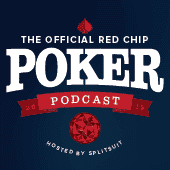Poker Downswings: A Survival Guide
As Jonathan Little said back in episode #4, if you are serious about playing poker, you will go through downswings so long and brutal it’s hard to believe. No matter how well you play, some day you will loose all the coin flips, fall victim to all the suck outs, and your results plummet.
This episode is all about how to deal with downswings. We talked to our roster of coaches to get different perspectives on how they passed the test of the severe downswing. And, as always, we found some common threads throughout.
Gano: Stay Hungry
Kicking things off, Gano’s advice will hit you in the face like a ton of bricks. He dealt with his first critical downswing by quitting poker.
“What kind of advice is that”, you ask? Poker is a game of survival and perserverance — and passion.
Gano went back to his 9-to-5, but he spent every possible hour of time he had outside of work studying poker. His passion for the game was too great to give up.
“When you have a really bad day and horrible results… it’s that hunger and that passion, the next morning, when everything is bright and fresh and full of potential, that gets you back into it.”

James: Talk to Good Players
What did Gareth James do when his bankroll took a $1000 swing south?
First, he sought the advice of psychologist and poker life coach Dr. Tricia Cardner, picking up her book Positive Poker and Tweeting for advice.
Second, he sought the advice of other good poker players, to plug whatever leaks were making the downswing worse, and to gain more confidence that he was just going through a rough patch of the type that every serious poker player will encounter.
“Looking at the graph on SharkScope horrified me and made me want to fix things.”
Haynie: Be Honest with Yourself
Haynie talks about the enormous stress of seeing your bankroll shrink. His method for dealing with it is to criticize and critique his own play via every available avenue, to first eliminate the possibility of a leak and then systematically tackle the negativity until a positive lesson can be learned from it. Honesty with oneself is the key, and sometimes that means checking your ego and dropping a level.
“Make sure you are objectively in a +EV situation.”
Related Article: Recording Every Hand in a Live Session
Little: Manage Your Bankroll for Confidence
As an MTT expert, Little knows something about downswings. How about a $450,000 downswing from peak career earnings? Yeah, settle in for this story.
Little says, “I was never gambling in my mind.” The key, he says, is bankroll management — specifically, keeping a large number of buyins for the level he’s playing at.
For Little, downswings are inextricably tied to bankroll management. Every poker player will encounter them, you can bet on it. But so few poker players actually plan with their money, and make sure their bankroll can take a hefty hit without worrying about running out of buyins to get back to winner status.
“You have to recognize that downswings are inevitable.”
Related Infographic: Avoiding Psychological Traps in Poker
Cardner: Double Down
Dr. Cardner ran brutal at the WSOP last summer, with card deadness and bad spots abounding. The life of an MTT player can often feel like one big downswing punctuated by moments of ecstasy.
Cardner’s advice, as a psychologist and a player, is to double down on every aspect of your game. She’s a fan of immersing herself in poker books, poker videos, poker conversations, and poker forums. Use the downswing as fuel for motivation in improving your game.
“Power through it.”
Related Article: How to Learn Poker (from Videos)
Soto: Review, Review, Review
All you can really do in this game, Soto says, is grind off the table with more study and introspection. Echoing the sentiments of our other coaches, Soto sees downswings and losing as inevitable. The clear way through the turmoil is to put maximum effort into improving every aspect of your game and overwhelming bad luck with finely honed skill.
“Every single time I’ve lost recently, I’ve made sure I’m OK mentally, made sure my line is strong, reviewed it with my friends, and then came back stronger.”
Related Podcast: How to Study and Improve Faster
Hull: Get a Fresh Perspective
Hull used a “data geek” trick to put things in perspective while on a massive $9,000 downswing. After ordering his session data randomly, he saw a steady upward graph, reinforcing his confidence that his overall game was strong.
When you think you’ve forgotten how to win, take a step back and look at your game. Chances are, you haven’t forgotten, you’re just getting downtrodden by the chips being spirited away. Spin your perspective around for a fresh look at your overall game.
“Looking at the big picture instead of the microscope of the last few months reminded me I’m a winning player.”

I’m a low stakes, recreational online nl hold em player. I’m probably a little above average in skill. I’m a huge fan of SplitSuit’s videos, but the two I consider the most important of all are these:
The Basics Of Poker EV | Poker Quick Plays
Advanced Poker EV Formula | Poker Quick Plays
My reason is that I think the most important thing a player needs to have is a solid understanding of how probabilities work in situations that involve random distributions, in particular the law of averages. In the videos is a simple graph that makes it completely understandable. There is the mathematical, expected line, a straight line, and the actual results line, or variance, which wanders all over the place but always finds it’s way back to the straight line. Arbitrarily pick two points on the variance line and somewhere in there you will find a downswing, an upswing, and every other kind of swing. Over your poker life, you start with the first hand you ever play and end with the last. Picking sections of your variance line are just arbitrarily picking starting and stopping points. So long as you really understand how probabilities work, what you see as swings are just short term starting and stopping points in your overall variance line. Yes, they will and should have a huge emotional impact on you. If they didn’t, you wouldn’t be human. But knowing that it’s the “downswing” that makes the “upswing” possible makes suffering through a downswing more tolerable. As long as you review your play and see that regardless of outcomes, you are still making the best EV decisions you are capable of and not making big mistakes, you can relax as best you can and wait for your friend the law of averages to kick in and put a smile back on your face. 😀
Well said Large!